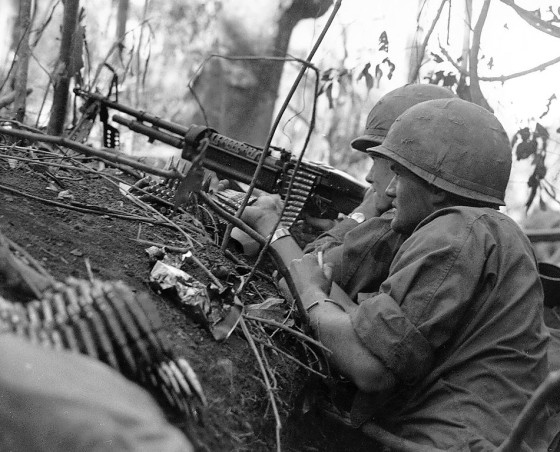
“While some of his early projects for Uncle Sam consisted of simple recruiting films… Huston’s more memorable work would come later – and it would come from the front lines.”

LEGENDARY AMERICAN movie director John Huston already had one blockbuster under his belt when he answered the call of duty.
Just weeks after the premiere of his Humphrey Bogart film noir classic The Maltese Falcon, Japanese planes bombed Pearl Harbor and the 35-year-old Missouri-born auteur and future director of The Red Badge of Courage, The African Queen and Moby Dick put his career in Tinsel Town on hold to enlist.
Assigned to the motion picture division of the U.S. Army Signal Corps, the newly minted Captain Huston focused his considerable cinematic talent on documenting the American war effort.

While some of his early projects for Uncle Sam consisted of fairly innocuous recruiting pictures like Winning Your Wings (SEE FULL MOVIE BELOW), an Air Corps short featuring movie star-turned-combat-pilot Jimmy Stewart, Huston’s more memorable work would come later – and it would come from the front lines.

In 1942 when American troops arrived on Adak Island to defend Alaskan territory from Japan, Huston was there too. His resulting 47-minute full-colour documentary, Report from the Aleutians (SEE FULL MOVIE BELOW) provides a compelling visual record of one of the war’s most far-flung and forgotten campaigns. The director himself narrates.
Military censors objected to a number of sequences in the movie, namely a fatal air crash on the island, as well as some unguarded moments in which slovenly-looking GIs are seen smoking and digging latrines – images that flew in the face of the image of the clean-cut American fighting man the War Department publicists strove to cultivate.
Huston pushed back and the offending footage stayed. But that would not be the end of controversy for the maverick filmmaker.

While embedded with the U.S. Army’s 36th Infantry Division during the 1943 Italian campaign, Huston and his crew found themselves neck-deep in the action as the Allies tried to punch through the heavily fortified Winter Line near Naples.
The hours of film captured during the assignment were eventually whittled down into a brisk 32-minute documentary dubbed The Battle of San Pietro (SEE FULL MOVIE BELOW). By all accounts, it was a sobering narrative of the fighting in Europe. And not everyone was pleased by Huston’s tell-it-like-it-is take on the war.
Mixed in among shots of U.S. troops under fire were some arresting visuals of dead American soldiers – something that was considered off-limits by morale-obsessed military censors.
The top brass condemned Huston’s no-holds-barred approach to film making as nothing short of subversive. In fact, for a time it looked like The Battle of San Pietro was destined for the the vault. It was only through the personal intervention of U.S. Army Chief of Staff George C. Marshall that the director’s masterpiece ever saw the light of day. In fact, the general made sure that San Pietro was even screened fo recruits in order to show the green GIs what to expect at the front. The following year, the film was playing in civilian movie houses stateside.
His military career salvaged, Huston was promoted to the rank of major and awarded the Legion of Merit.

Huston’s final wartime project was the 1946 documentary Let There Be Light (SEE FULL MOVIE BELOW). And true to form, the hour-long movie pulled no punches as it charted the slow rehabilitation of U.S. servicemen suffering from what today would be called Post Traumatic Stress Disorder (PTSD).
Initially keen on the project, the military ultimately balked at some of the film’s emotionally charged subject matter and at the last minute prevented Let There Be Light from being screened — censors pulled the plug on film’s premiere in New York just moments before the curtain went up. It wasn’t until 1980 that the Pentagon allowed the film to be seen. The original master was only recently restored by the National Film Preservation Foundation.
With the war over, Huston left the service and was soon back in Hollywood working on his next project,1948’s Oscar-winning The Treasure of the Sierra Madre. He’d continue making films until his death in 1987.
Winning Your Wings (1942)
Report from the Aleutians (1943)
https://www.youtube.com/watch?v=hVLTrJmLdiM
Battle of San Pietro (1944)
https://www.youtube.com/watch?v=xssaWNoWq3E
Let There Be Light (1946)
https://www.youtube.com/watch?v=LlBhCsBsUQ4









